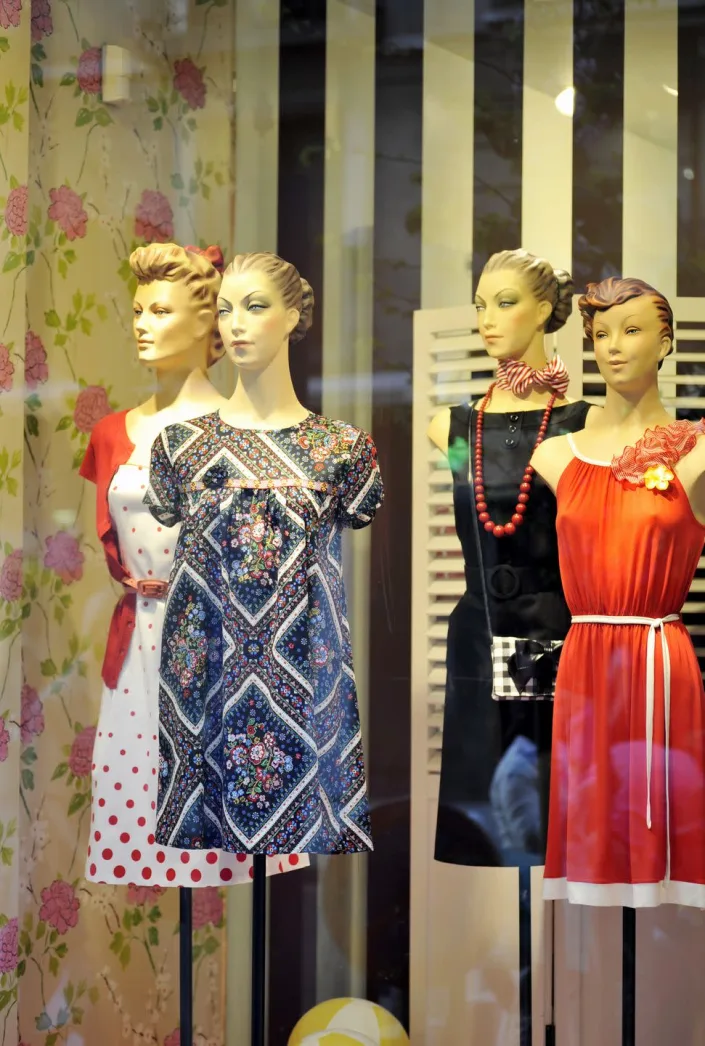
To pluck a periwinkle item out of the stack, Alicia Siemens pushes her arm back into the sagging bag of flannel and graphic t-shirts. She reveals a 1970s peasant dress with a floral motif when she raises it up to her chest. She touches a faded lace collar and remarks, “There’s some discoloration, but we should be able to do something with it.”
It’s Not Who You Are, It’s What You…WEAR” faded t-shirt, crumpled cashmere cardigan, and ’90s cargo pants are among the roughly a dozen other items that Siemens and coworker Amanda Sanchez had left aside and thrown into a neighbouring shopping cart. Numerous six-foot-tall heaps of old clothing are waiting for release behind her, each carefully wrapped in ragged blankets and fastened with wire.
It is Seimens’ responsibility as a vintage shopper for Reformation to trawl through public and private rag houses like this one in search of one-of-a-kind items. Each week, she travels to a number of the unmarked warehouses outside of Los Angeles and spends four to five hours rummaging through bales of various garments that are frequently unclean and occasionally sorted.

Most warehouses lack heating and air conditioning. The stacks have been brought outside today in the scorching mid-August heat and covered with a sheet. As another warehouse worker stacks the bales with a forklift, a manager stops by to see how she’s doing. Every container is labelled; neither she nor them disclose to Siemens where their supply comes from.
In between her exclusive shopping visits, Siemens will visit thrift shops, browse friends’ vintage shops, or make calls to contacts with specialised knowledge—her denim guy and her sunglasses guy (Gucci, bay-bee!
Almost everything that Reformation’s vintage buyers find is resold. Some of it is offered for sale as “one-of-a-kind,” the brand’s term for authentic vintage, online or at one of its specialised vintage locations in Los Angeles, New York, or London. Additionally, it offers “upcycled styles”—items created by the vintage team using previously owned clothing—for sale. The next step is “remade,” where famous Reformation designs or vintage-inspired silhouettes are created using rolls of deadstock cloth. The crew occasionally comes across some bulk necessities, like a few hundred tank tops or vintage sweaters.
Siemens and Sanchez move fast, frequently without pausing to examine their attire. By feel and touch, they identify cashmere or cotton twill thanks to muscle memory.
Sanchez declares that Alicia is “the textile queen.”

Tees slow you down, but I can do denim without thinking,” Siemens asserts. You must pause to read them.
They’re halfway through their first bale at ten in the morning. While Siemens won’t provide specific figures, she assures me that the Vintage crew has “sales targets just like the rest of Ref—we’re just as business-oriented.” The objective is to complete at least three more in order to achieve their monthly goals, then leave before the temperatures reach the mid-90s.
They are “fresh picking” through a bale that hasn’t been handled by any other buyers. After Siemens and Sanchez are done, the rag house team will give other clients, such smaller vintage shops and foreign buyers, a chance to participate.
According to Siemens, who has been purchasing from the store frequently for years, “they open the packs fresh for us and are always eager to learn about our business.” They’ve recently learned that we’re seeking for additional Y2K material. We’ve tried so hard for years to avoid consume this stuff, they keep saying in jest. The more effectively you cultivate relationships, the more successful you’ll be in this area of employment.
Bales are piled up to the ceiling inside the warehouse on sturdy shelves. Fur stoles pour from one. According to Siemens, there is a second warehouse right next door.
I’m having trouble understanding where it all comes from. Donations from thrift shops? If so, are you from Los Angeles? the remainder of the nation? Is it all utilised? And why is it so filthy in general?
Siemens, who is usually unflappable, becomes tense. They are involved in this. They dislike being questioned frequently, she claims. I notice that not a single member of the staff of the rag home has spoken to me since Siemens informed them that I was a writer.
Later, I get in touch with American Recycled Clothing’s (ARC) design director, Elvia Lahman, who describes ARC as a “secondary” rag house as opposed to a “genuine” rag home like the one Siemens and Sanchez and I visited in August. The difference: ARC sorts and grades items (“A: perfect condition. B: minor blemishes or holes, but still fashionable. Pit stains are C. Unless it’s an authentic Rolling Stones T-shirt from the 1970s, nobody wants these, said Lahman. Buyers are forced to pay more for whatever they find in exchange.
When I tell her that I can’t get anyone to explain how a rag home operates, she laughs. Loosely speaking, Goodwill and the Salvation Army receive a tonne of donations, according to Lahman.
Rags can occasionally become gold. I see Siemens remove a woven and embroidered huipil outfit from her pile in the “real” rag house. Maxi length, authentic vintage from Mexico, most likely from the 1960s, in immaculate condition It is thrown into the “no” bin by Siemens. She claims, “It’s not our customer.” “Whoever comes after us will get it,” the speaker said.





























